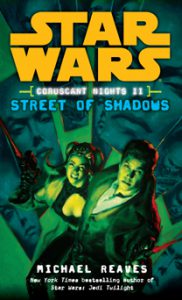Michael Reaves steps up his game in “Coruscant Nights II: Street of Shadows” (2008), which has more of a true mystery plot than the trilogy’s first book and even better tie-ins to the wider Expanded Universe. While there are continuity oddities and plot conveniences, it’s a compulsive page-turner and Jax Pavan’s gang of renegades is more engaging now – if only because we’ve spent more time with them.
The “Coruscant Nights” trilogy is ostensibly about Jax being a private investigator on the downlevels of Coruscant, but the first entry, “Jedi Twilight,” didn’t have a contained mystery; this one does. A Caamasi light painter is murdered, and his assistant, the Zeltron Dejah Duare, hires Jax. It culminates in a satisfying Sherlockian reveal that the house droid committed the murder. While this doesn’t align with Isaac Asimov’s law that robots cannot do harm to sentients, the “Star Wars” galaxy has no such rules; indeed, there are several examples of evil droids, including the feral droids at the end of “Jedi Twilight.”
“Street of Shadows” includes many wonderful tie-ins to the wider saga. The arc of Captain Typho, Padme’s bodyguard from “Episode II,” reads like an entry from those “Tales of …” books; there was never a “Tales from the Prequels,” but this serves the same purpose. We learn that Typho wants to avenge Padme, whom he loved from afar – one of the few details that stuck with me from my first read. The way Typho links Vader to Padme’s death is too narratively convenient. He goes to an information broker, who immediately tells him what viewers know from “Revenge of the Sith” (p. 199):
The strictly prohibited records that the slicer’s family had somehow managed to access indicated that one Darth Sidious had journeyed to Mustafar, was there at the same time as Padme and Anakin Skywalker, and had returned shortly thereafter.
(Really, Sidious was keeping records of that? Or, alternately, a spy knew Sidious’ name?) Typho then apparently makes the leap that Sidious and Vader are one and the same.
Still, it culminates in a gripping confrontation between Typho and Vader. Naturally, Vader kills Typho (although this contradicts Typho’s “Star Wars Galaxies” game appearance later in the timeline, I’m not too troubled by it). But before doing so, he admits he “killed” Anakin Skywalker (page 283):
“Yes, I killed Anakin Skywalker. I watched him die. He was weak, was Skywalker. In the end, he could not rule himself, could not control his contemptible human emotions. Most of all, he did not understand or appreciate the true strength of the dark side. And so – he died. The galaxy is better off without him.”
Arguably, it might’ve been more fun if Vader told the dying Typho that he IS Anakin Skywalker, but this passage does illustrate Vader’s developing sense of identity, which will eventually lead to him telling Luke in “Return of the Jedi”: “That name no longer holds any meaning for me.”
Reaves is hesitant to write from Vader’s point of view, preferring to play up the 1977 perception of Vader as the ultimate black hat (p. 282):

That brief pause was followed by the horrible sound of a Sith Lord laughing. Three levels below, a pair of intoxicated humanoids heard just the echo of it and were immediately shocked into sobriety – the fearful clearheadedness that comes with realizing that untold terror lurks nearby.
And when Jax and Laranth sense Vader nearby, to the north, Den Dhur suggests they move south, quickly.
The dearth of Vader’s POV is somewhat disappointing when he hires Aurra Sing, considering that Anakin and Sing did have some encounters before this in the Dark Horse comics. Picking up on Sing’s arc from “Jedi: Aayla Secura,” where the Jedi hunter is thrown into a prison planet work detail, Vader commutes Sing’s sentence so he can hire her to hunt Pavan.
As with Typho’s demise, Sing’s demise when Jax knocks her into the maw of a construction droid is a bit of a continuity problem, but this time it doesn’t affect just a game (2000’s “Demolition”) but also the novels – she appears later on the timeline in 2006’s “Legacy of the Force: Tempest.” Reaves’ prose isn’t ambiguous (p. 298): “Sing looked up at him as she sank beneath the sand. It churned while she was sucked into the machine. The last he saw of her was a splotch of red hair.” I guess we have to file this under “If you don’t see a corpse, don’t assume she’s dead,” but it would’ve been nice if we found out how she survived.
In “Street of Shadows,” we only get the slightest hint as to why Vader is so interested in Jax: Anakin once trusted Jax with a nugget of pyronium. I hope we get a robust explanation for Vader’s obsession in book three, but right now, the storyline feels too much like the author is biased toward his own character. While there are plenty of other Force-users out there (including Jax’s colleague, the Twi’lek Laranth), this feels like a case of “Jax is the main character, so therefore the villain is targeting him.”
Sometimes Reaves doesn’t emphasize the right things. We know from a brief explanation that Laranth lost part of her lekku during Flame Night, when the Inquisitorius wiped out a bunch of hiding Jedi soon after the events of “Episode III.” We also know Laranth is not technically a Jedi, but rather part of a rogue sect called Gray Paladins, who prefer blasters to lightsabers. There’s a juicy “Laranth’s Tale” there, but we never get it, and as in “Jedi Twilight,” she is underexplored here. Even when she reveals to Jax that she likes him romantically, he simply notes that he doesn’t feel the same way, and she decides to leave the group.
While Reaves skims over his own backstory inventions, he does expand on Timothy Zahn’s destruction of Caamas, first mentioned in the “Hand of Thrawn” duology when the Caamas Document implicates Bothans. In “Street of Shadows,” the Caamas tragedy happens (albeit off-page) when the Emperor uses the military to wipe out most of the Caamasi. This is not only a narrative link to Zahn’s work, but it’s also a great way to show how Palpatine’s planet-destroying terror didn’t start with Alderaan; it started with Caamas, but that didn’t have as big of a galactic impact due to human bias. Additionally, the Caamas strike shows how Palpatine works to install a more human-centric government and a more human-dominated Imperial Center. Indeed, while Whiplash was seeking to move Force-users off Coruscant in “Jedi Twilight” through its UML (Underground Mag-Lev), they focus on getting non-humans to safety in “Street of Shadows.”
More fun items make “Street of Shadows” feel like it’s part of the wider fabric: Dejah is a Zeltron, and this is the most robust use of that sexy species (introduced back in the Marvel comics) in a novel. Reaves has fun with it, notably in a scene where Jax is distracted by Dejah’s suggestive attire as he’s trying to work the case. Typho’s exchange with a Jenet bureaucrat – laden with insults, as that’s how Jenet prefer to communicate – is also entertaining. Cragmoloids and Cathar also pop up, and Reaves invents Cephalons – whose minds can perceive the fourth dimension. This is perhaps too much of a sci-fi indulgence, especially since Jax makes no use of the Cephalon’s prophetic clue.
In the end, “Street of Shadows” has a lot of hits and some misses, and as with “Jedi Twilight,” it has an ephemeral quality that allowed me to read it a second time as if it was my first read, as I had forgotten most of what happened. It leaves me equal parts intrigued and worried about the culmination of Vader’s pursuit of Jax in the third entry, “Patterns of Force.”

